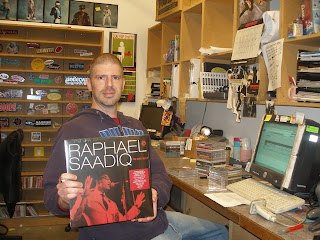One of the sheer joys of being in an indie record store is browsing the bins. Just starting somewhere, flipping through things, pulling out items that catch your eye, giving a few of them a test spin. So in the seventh of a hypothetical series, I've browsed the "New Arrivals" bins here at Twist & Shout, picked out a few things, and gave them a listen. The nature of used record stores being what it is, I can't promise these items will still be in the bin by the time you get here. But hey, browse the bin anyway. You might find something else of worth.
CD -
Rod Stewart -
The Definitive Rod Stewart 
There's a certain type of
Rod Stewart fan. Those who, when they first hear the words "Rod Stewart", immediately flash onto songs like "Handbags and Glad Rags." Who still think of Rod as "that guy from
the Faces."
Those fans probably don't need me to tell them this, but they're gonna want avoid this disc like the plague.
For the rest of us, this two-CD set is about as good a collection as you're bound to get. It obviously uses the pop singles chart as a basic guide, so there's a lot more MTV hits than "classic early sides." But I don't consider than necessarily a bad thing. Yeah, I understand that, oh, "An Old Raincoat Will Never Let You Down" is a "better" song than, say, "Some Guys Have All the Luck." Yeah, "Tonight I'm Yours (Don't Hurt Me)" is a really dumb song. The lyrics are horribly contrived even from a "let's have a one night stand" perspective, the weird high-pitched "whoo"s at the end sound like a four-year-old girl on a roller coaster, and the synth lines were already sounding dated back when the song came out in 1981. But you know what? I still like the damn thing. I recall watching the I-guess-this-is-sexy video back in the day, and wanting a neat shiny pink vinyl jacket and visor combo like
Rod sported. And I wanted to have a fun bikini-clad party at a Best Western, too, culminating with me pushing my guitarist into the swimming pool at the end of the night. These are the sorts of weird but fun memories that "Raincoat" just can't deliver. Pile on top of that all the memories (or baggage) concerned with "Young Turks" and "Tonight's the Night (Gonna Be Alright)" and all the rest, and you might understand why I'd drag this CD off the rack more often than
Every Picture Tells a Story.
No, of course the collection isn't "definitive." There's that obligatory "new" song at the end that isn't worth much. And even I think it gives the early years short shrift. And there's a lot of later stuff that I don't really need to hear. But then again, there's probably a guy about ten years younger than me who has similarly weird memories about "Rhythm of My Heart" and "Downtown Train" to those I have about "Passion." In which case, good for him.
LP -
Neil Norman & His Cosmic Orchestra -
Greatest Science Fiction Hits (Volumes 1 & 2)  Neil Norman
Neil Norman has a pretty odd gig. Well, he's a bigwig at GRP/Crescendo Records (the home of these two recordings), but it's his other gig that's the real strange one. Imagine going to a science-fiction convention (or, if you've actually done this, think back to your last visit). Now imagine a group of people in silvery spacesuits, playing lounge-y/future-y versions of classic sci-fi themes. Well, the head guy in silver is
Neil Norman. That's his gig. Playing sci-fi songs at sci-fi conventions, and anywhere else there's a market for guys in silver spacesuits playing sci-fi songs. And
Neil's been doing it for almost three decades.
These two LPs are from the start of his career, and it pretty much set the stage for what came after. It was as the 70s gave way to the 80s, and
Star Wars found a much larger audience for sci-fi than anyone thought possible. On each LP,
Neil works this to his advantage, performing arrangements of various sci-fi tunes. The track selection is rather broad - it ranges from the obvious ("Close Encounters") to the obscure ("Phantom Planet") to the

bizarre ("Can You Read My Mind" from
Superman), and he even finds time to perform a couple of originals ("Not of This Earth," "Vampire Planet") that fit in quite well. The term "Orchestra" may be a bit of a stretch, but he does have fourteen musicians credited, so it's certainly more than just "a guy and his keyboard." And how does it sound? Well, as good as it possibly can, I guess. The band is quite good, the tunes are often deftly arranged, and
Neil even adds some killer guitar solos here and there. But, you know, it still comes down to that basic fact - these are future-y versions of classic sci-fi themes. There seems to be some limit as to how high this stuff can climb. To his credit,
Neil generally gets to that point, even if he can't transcend it. I think these albums would make great background music for a fun party. Assuming your friends have a bit of a sense of humor, anyway.
12" -
Earons -
"Land of Hunger" 
The 80s nostalgia kick seems to be ending, which is fine. Not that I didn't love the 80s and all, but I've gotten to the point where my memories of the
Flock of Seagulls are more of people talking about how dumb Mike Score's haircut in the "Space Age Love Song" video looked than they are of...well, "Space Age Love Song." And that's why it's fun to come across a song or band that really wasn't touched by the 80s nostalgia kick.
And yes, I'm totally aware that I'm about to ruin that for this song. Pretty meta. Anyway.
The Earons were yet another new wave band with a gimmick, but theirs was at least simple to set up and maintain. In the genre where image was at least as important as substance, the
Earons went with a "non-image." The band only appeared in white jumpsuits and motorcycle helmets, and individual members were to be referred only by number. (The lead vocalist? 28.) The music's pretty good - a reggae-influenced synth-based dance song with "aware" lyrics. Three versions of that song might be a bit of overkill, but considering that this song isn't one you stumble across on "Best of the 1980s" albums, it's probably worth picking up. The song did hit number one on the dance chart in 1984, but the band was pretty well forgotten a year later. But that's what makes the song so fun. Everyone remembers "Come On Eileen," and not everyone is going to instantly remember the tune. However, this IS the sort of song that will make some people stop, open their eyes wide, and say "Oh YEAH!" And that's always a fun feeling.



























